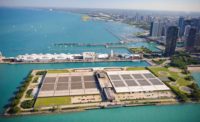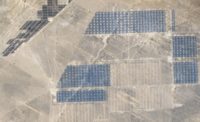Refinery construction is primarily driven by demand for oil products. "Demand growth for oil products is currently strong and will remain so for at least this year and next," says Richard Joswick, managing director of PIRA Oil Group at Platts. "Over the medium term, although we think it will slow somewhat, it will still remain quite healthy. We do not see any 'peak demand' for oil any time soon."
"Global refined-product demand is expected to grow by about one million barrels per day per year for the next decade, and that growth will require refinery capacity expansion," says Rebecca Adler, senior director of communications at the American Fuel and Petrochemical Manufacturers.
"There's a need, long term, for new refineries globally," adds Joswick. "We've seen a lot of refinery growth in rapidly developing countries—in the Middle East, India and China. We’ve seen incremental growth in the U.S., where there are de-bottlenecking projects, because demand is still growing. Refinery margins were very good in 2015, good in 2016 and are good now.”
A similar perspective is provided by Jacobs, which does extensive, ongoing refinery work for major clients. “We expect the best markets for refineries to be in non-OECD [Organisation for Economic Co-operation and Development] countries, specifically those in Southeast Asia, as they move away from imports and toward self-reliance in transport fuels,” says Shaun Boardman, vice president of technology at Jacobs Petroleum & Chemicals.
Joswick sketched out the cyclical nature of the refinery market, with its high cost of entry, high capital costs and long lead times. "We're now in a place where refinery capacity growth has come down. Growth in 2017, 2018 and 2019 will be less than in the past five years, since margins were poor when these current projects were commissioned. There are good margins now," he says. "I expect we'll see a construction surge starting in 2019. Refineries are always five years behind the times because it takes five years to go from concept to planning to design to permitting to construction and startup to commercial operation."
Another factor influencing refinery construction is an upcoming global specification change for bunker fuel, which takes effect on Jan. 1, 2020. The global sulfur cap of 0.5% was promulgated by MARPOL Annex VI, an international marine-pollution convention. Representing over 90% of global trade, 88 countries have agreed to the cap. “Three million barrels per day of refinery output of bunker fuel will have to switch from high sulfur to low sulfur,” explains Joswick. "There’s no easy way to do that—only expensive ways. Refiners that have coking capacity will make a huge amount of money. Other refiners will hurt. This will cause a scramble for the kinds of units that will produce low-sulfur bunker fuels—coking and hydrocracking units. I would expect to see a spurt in construction to meet that demand."
The Al Zour Refinery, in Kuwait, is the largest greenfield refinery being built anywhere in the world; it is expected to have a capacity of 615,000 barrels per day. The estimated construction cost is $16 billion, and it will more than double the country’s processing capacity when completed in 2019. So far, the Kuwait National Petroleum Co. has awarded $12.8 billion in five packages.
The first contract, worth $4.2 billion, was awarded to Technicas, Hanwha Engineering & Construction Corp. and China Petroleum & Chemical Corp., known as Sinopec. The second and third packages, worth $5.7 billion, were awarded to Fluor Corp., Daewoo and Hyundai Heavy Industries Co. According to Fluor's Jim Brittain, the joint venture they are leading on those two packages "is using a modular execution approach, with peak labor on site expected to be around 17,000 people."
The fourth package, worth $1.55 billion, was given to Saipem SpA and Essar Oil Ltd., and the fifth package, worth $1.48 billion, was awarded to Hyundai Engineering & Construction Co., Saipem and SK Holdings Co. Ltd. It will process heavy crude from Kuwait into low-sulfur diesel, high-value light products and fuel oil to feed power plants within Kuwait.
Nigeria is taking a huge economic leap, as the large cement manufacturer Dangote Group is developing a $12-billion greenfield refinery, near Lagos. Engineers India Ltd. is performing engineering, procurement and construction management for the refinery and an associated polypropylene plant. The project will include a crude distillation unit, a single-train residual fluid catalytic cracking unit and a diesel hydrotreating unit. When the plant begins operating in 2019, it will have a capacity of 650,000 bpd.
The Sturgeon Refinery is the largest refinery construction project underway in North America. For the first refinery built in Canada in 30 years, construction involves 7,500 workers at a site 45 kilometers northeast of Edmonton, Canada. Estimated to cost $8.5 billion and expected to begin operations in late 2017, Sturgeon's first phase will process 79,000 bpd of bitumen and diluent blend. The North West Redwater Partnership, a 50-50 alliance between MacGregor’s North West Refining and Canadian Natural Resources Ltd., is the owner and operator. Fluor is responsible for three units on the project. "We have been involved in the project since the front-end engineering and design phase in 2011 and have applied a number of construction innovations on the project, including an integrated scaffolding program that has been recognized by Fiatech for its improvement to project planning and innovation,” says Jim Brittain, group president of energy and chemicals at Fluor.
"Modularization has proved to be a key part of achieving cost and schedule certainty," says Brittain. "Project work is moved offsite to fabrication yards, where components are assembled and then shipped to site. It reduces on-site labor and congestion, improves safety [through a reduced need to work at heights] and moves work to a more productive environment." He adds, "While modularization has been used in Canada and other countries for many years, we are now applying it to other locations because of the predictability it brings, including both the Sturgeon Refinery project in Canada and on the Al-Zour Refinery in Kuwait. We have close to 200 modules on the Al-Zour project and 358 on the Sturgeon Refinery project."
Given the huge scale of refinery projects, contractors are seeking new approaches to improve execution. "Unlike the traditional approach to construction, we engage our construction teams in the early stages of a project, during front-end engineering and design, to ensure work packages are developed with construction in mind," says Boardman. "Through our construction-readiness reviews, we review what is needed early and begin working deliverables, including commissioning and turnover plans, and so on. We also help engineering with sequencing. This benefits our clients by improving productivity during construction, reducing schedule and maximizing return on investment."
Boardman continues, "Another key element to overcoming the planning and scheduling challenge is project oversight. A project team is inherently optimistic, including the customer. We provide independent oversight throughout the life of a project, which includes reviewing and discussing the realities of indicators and issues as well as how to overcome these challenges."
Reduced capital spending has spurred contractors to devise creative solutions. "Refinery owners across the globe are faced with the reality of reduced capital expenditure budgets, so they are adapting, learning and collaborating in order to do more with less," says Mark Ashwin, regional operations manager for Bechtel’s downstream and chemicals business line. "Our integration across functions throughout project development enables us to efficiently innovate across the entire EPC value chain.
"For example, in Indonesia, we are working with Pertamina to enhance their project management capacity and develop procedures and methods to improve the efficiency of project development and execution," Ashwin notes. "It's a very interesting process of sharing, comparing and combining our respective EPC experiences.
"On the construction side, major challenges we see on our downstream and petrochemicals projects across the globe are primarily an increase in complexity that leads to challenges with construction productivity as well as availability of qualified craft," Ashwin observes.
A proposed South Texas oil refinery is expected to break new ground in terms of its environmental impact. It will be colocated with a geothermal power plant, a brine desalination plant and carbon capture and sequestration to create what the developer-owner is describing as the cleanest refinery in the world.
Renewable geothermal energy will power the refinery. Early cycles of geothermal power will be generated using high-temperature brackish water, while later cycles will rely on the refinery's own carbon-dioxide emissions for power. Captured and pumped deep underground, the pressure and heat will make those emissions supercritical, then they will be drawn back up to drive the geothermal power plant’s turbines.
Owner Raven Petroleum LLC, The Woodlands, Texas, has signed memoranda of understanding with Thermal Energy Partners LLC, Austin, and Basic Equipment, Houston, to build the South Texas Energy Complex, near Hebbronville. The refinery will process up to 55,000 barrels per day of Eagle Ford shale oil for Raven, producing gasoline and low-sulfur diesel. Thermal Energy will design and construct a geothermal power plant with a capacity of up to 20 MW to power the refinery. Basic Equipment will perform engineering, procurement and construction for the refinery and construction management for the complex.
With the geothermal plant fully integrated, the total cost of the project will be about $500 million, says Christopher Moore, Raven's managing director. Engineering design is expected to be completed by June 2017, followed by permitting; construction is expected to begin sometime in 2018.














Post a comment to this article
Report Abusive Comment